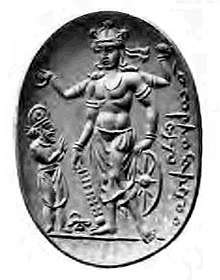Vishnu Nicolo Seal

The Vishnu Nicolo Seal is a famous seal (1.4 inches by 1.05 inch) from the Indian subcontinent, dated to the 4th-6th century CE. It is now located in the British Museum.
The seal depicts the four-armed god Vishnu, being prayed by a devotee. Vishnu holds his classical attributes: the gada club, the chakra discus, the wheel and the lotus.[1][2]
The seal was first reported by Alexander Cunningham in The Numismatic Chonicle of 1893.[1][3] Cunningham, saw in the devotee the Kushan ruler Huvishka, based on the similarity of the headdress.[2]
More recent research, however, has permitted the complete deciphering of the seal by Ghirshman and given a different interpretation of the scene. The text on the seal is said to be the Kushan script and mentions three major Hindu gods:
This recent research also identified the devotee, not with Huvishka, but with a Huna king.[3][2]
The seal also suggest that a composite cult of the three deities Surya (another name for Mihira, meaning "Sun"), Vishnu and Shiva was current in India circa 500 CE.[3]
.jpg) Vishnu, with similar attributed, Udayagiri Caves.
Vishnu, with similar attributed, Udayagiri Caves. The devotee in the Vishnu Nicolo Seal (detail).
The devotee in the Vishnu Nicolo Seal (detail).
References
- 1 2 1893 Numismatic Chonicle p.126
- 1 2 3 Śaivāgamas: A Study in the Socio-economic Ideas and Institutions of Kashmir (200 B.C. to A.D. 700) V. N. Drabu, Indus Publishing, 1990 p.201
- 1 2 3 4 Buddhism in Central Asia, by Baij Nath Puri, Motilal Banarsidass Publ., 1987, p.131-132
- ↑ Religion and Society in Ancient India, Pranabananda Jash - 1984, p.304